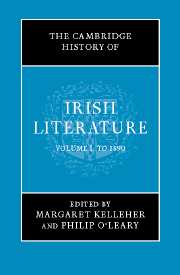Book contents
- Frontmatter
- Introduction
- 1 The literature of medieval Ireland to c. 800: St Patrick to the Vikings
- 2 The literature of medieval Ireland, 800–1200: from the Vikings to the Normans
- 3 The literature of later medieval Ireland, 1200–1600: from the Normans to the Tudors
- 4 Literature in English, 1550–1690: from the Elizabethan settlement to the Battle of the Boyne
- 5 Literature in Irish, c.1550–1690: from the Elizabethan settlement to the Battle of the Boyne
- 6 Prose in English, 1690–1800: from the Williamite wars to the Act of Union
- 7 Poetry in English, 1690–1800: from the Williamite wars to the Act of Union
- 8 Literature in Irish, 1690–1800: from the Williamite wars to the Act of Union
- 9 Theatre in Ireland, 1690–1800: from the Williamite wars to the Act of Union
- 10 Irish Romanticism, 1800–1830
- 11 Prose writing and drama in English, 1830–1890: from Catholic emancipation to the fall of Parnell
- 12 Poetry in English, 1830–1890: from Catholic emancipation to the fall of Parnell
- 13 Literature in Irish, 1800–1890: from the Act of Union to the Gaelic League
- 14 Historical writings, 1690–1890
- 15 Literature and the oral tradition
- Guide to major subject areas
- Index
- References
3 - The literature of later medieval Ireland, 1200–1600: from the Normans to the Tudors
Published online by Cambridge University Press: 28 March 2008
- Frontmatter
- Introduction
- 1 The literature of medieval Ireland to c. 800: St Patrick to the Vikings
- 2 The literature of medieval Ireland, 800–1200: from the Vikings to the Normans
- 3 The literature of later medieval Ireland, 1200–1600: from the Normans to the Tudors
- 4 Literature in English, 1550–1690: from the Elizabethan settlement to the Battle of the Boyne
- 5 Literature in Irish, c.1550–1690: from the Elizabethan settlement to the Battle of the Boyne
- 6 Prose in English, 1690–1800: from the Williamite wars to the Act of Union
- 7 Poetry in English, 1690–1800: from the Williamite wars to the Act of Union
- 8 Literature in Irish, 1690–1800: from the Williamite wars to the Act of Union
- 9 Theatre in Ireland, 1690–1800: from the Williamite wars to the Act of Union
- 10 Irish Romanticism, 1800–1830
- 11 Prose writing and drama in English, 1830–1890: from Catholic emancipation to the fall of Parnell
- 12 Poetry in English, 1830–1890: from Catholic emancipation to the fall of Parnell
- 13 Literature in Irish, 1800–1890: from the Act of Union to the Gaelic League
- 14 Historical writings, 1690–1890
- 15 Literature and the oral tradition
- Guide to major subject areas
- Index
- References
Summary
The literature of Ireland in the period covered by this chapter is characterized by a remarkable intellectual and artistic diversity shaped by a dynamic and not infrequently tense interaction between Gaelic, English and French cultures. Indeed such is the varied composition of the ethnic cultures of later medieval Ireland that discussion of the contemporary literature within a specific insular framework risks disregarding the diffuse and permeable boundaries of cultural expression. While literatures in French and English produced in Ireland constitute a local expression of vibrant metropolitan cultures, the ideological and aesthetic focus of the majority culture of the Irish-speaking population was centred on the island itself. Even in the case of Irish Gaelic culture, however, its reach and influence extended to the Gaelic-speaking regions of western and northern Scotland. Conscious of the strikingly modern cultural resonances of this obscured and little-known phase in Ireland’s literary history, the present chapter seeks to explore the development of writing in both prose and poetry in Irish and other languages within an inclusive framework of analysis. The literature of later medieval Ireland provides vivid testimony for contemporary ideological, social and religious beliefs; but perhaps more strikingly and affectingly, it provides a rare and valuable insight into the world-view and varied human emotions of the late medieval Irish literati and the men and women for whom they composed.
- Type
- Chapter
- Information
- The Cambridge History of Irish Literature , pp. 74 - 139Publisher: Cambridge University PressPrint publication year: 2006
References
- 2
- Cited by

